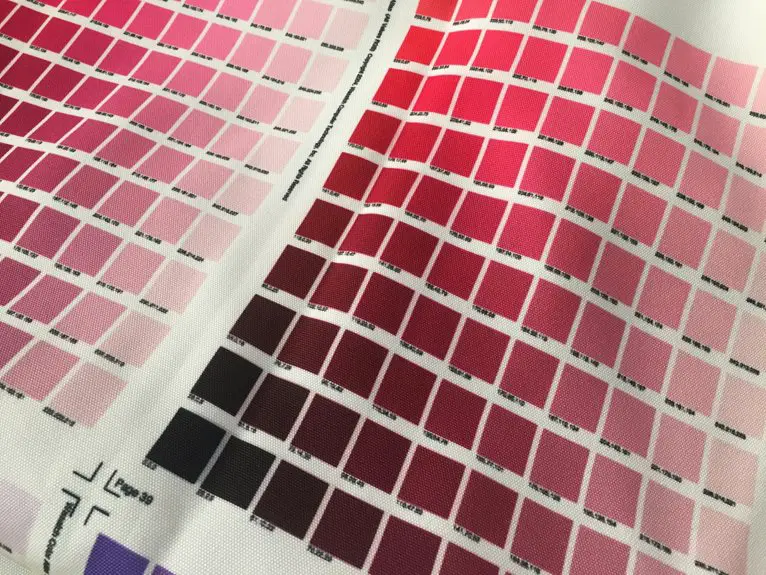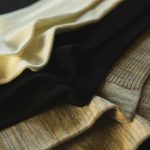If you want softer, stronger fabric that lasts longer, ringspun cotton is your best bet. It’s made by twisting and thinning fibers, producing a finer, more durable yarn with a smooth feel against your skin. Regular cotton is coarser and less resilient, wearing out faster. Though ringspun cotton costs more upfront, its quality and comfort pay off over time. Keep exploring to see how these fabrics stack up in every way.
Table of Contents
Key Takeaways
- Ringspun cotton fibers are continuously twisted and thinned, producing finer, stronger, and smoother yarn than regular cotton.
- Ringspun cotton fabric is softer, drapes better, and feels less stiff against the skin compared to the coarser texture of regular cotton.
- Ringspun cotton is more durable, resists pilling, and maintains shape and texture longer through multiple washes than regular cotton.
- Regular cotton is more affordable upfront but wears out faster, while ringspun cotton offers superior long-term value and comfort.
- Ringspun cotton is ideal for premium, fashion-forward apparel, whereas regular cotton suits disposable, less frequently used, or crafting items.
Understanding the Manufacturing Process of Ringspun and Regular Cotton
Although both ringspun and regular cotton start from the same raw fibers, their manufacturing processes differ greatly, affecting the fabric’s feel and durability.
When you opt for regular cotton, the fibers are simply twisted together in a single step, creating yarn that’s thicker and less refined.
In contrast, ringspun cotton involves an extra process where fibers are continuously twisted and thinned, producing a finer, stronger yarn. This additional step makes the yarn smoother and more compact.
As you follow the threads, you’ll notice ringspun cotton tends to be tighter and more uniform, which contributes to its resilience.
Comparing the Texture and Comfort of Ringspun and Regular Cotton
The finer, more tightly twisted yarn of ringspun cotton doesn’t just boost durability—it also creates a noticeably softer texture compared to regular cotton.
When you wear ringspun cotton, you’ll feel a smoother, more refined fabric against your skin, making it ideal for everyday comfort.
Regular cotton, while breathable and natural, tends to have a coarser texture due to its thicker, less twisted fibers.
This difference means that ringspun cotton garments usually drape better and feel less stiff or rough.
If you’re sensitive to fabric textures or want clothing that feels gentle all day, ringspun cotton is a smart choice.
It offers enhanced softness without sacrificing breathability, ensuring you stay comfortable whether it’s a casual tee or a dress shirt.
Durability and Longevity: Ringspun Cotton Versus Regular Cotton
When you choose ringspun cotton, you’re investing in fabric that stands up better to wear and washing. Its tightly twisted fibers create a stronger, more durable yarn that resists pilling and thinning over time. Regular cotton, while soft initially, tends to wear out faster due to its looser fiber structure and lower tensile strength.
Here’s a quick durability comparison:
| Feature | Ringspun Cotton | Regular Cotton |
|---|---|---|
| Fiber Strength | Higher, tightly twisted fibers | Lower, loosely spun fibers |
| Resistance to Pilling | Excellent | Moderate |
| Longevity | Lasts multiple washes | Wears out sooner |
| Fabric Integrity | Maintains shape and texture | Can lose shape quickly |
Cost Differences and Value for Money
How much extra are you willing to pay for quality?
Ringspun cotton usually costs more upfront than regular cotton because its fibers are twisted tightly to create a finer, smoother fabric. This process requires more time and skill, which reflects in the price.
While regular cotton might seem budget-friendly initially, it often wears out faster and loses softness sooner.
When you consider long-term use, ringspun cotton offers better value for money due to its durability and comfort. You’re paying more, but you also get a product that lasts longer and feels better against your skin.
Best Uses for Ringspun Cotton and Regular Cotton Fabrics
Choosing between ringspun cotton and regular cotton depends largely on how you plan to use the fabric.
If you want soft, durable clothing that lasts, ringspun cotton is your go-to. Regular cotton works well for basic, affordable items without heavy wear.
Here are the best uses for each:
- Ringspun Cotton: Ideal for premium T-shirts, hoodies, and casual wear where softness and longevity matter.
- Regular Cotton: Perfect for disposable or less frequently used items like uniforms or basic bedding.
- Ringspun Cotton: Great for fashion-forward pieces requiring a smooth texture and refined look.
- Regular Cotton: Suitable for crafting, lightweight curtains, and other home textiles where cost efficiency is key.
Choose based on the balance between comfort, durability, and budget.
Frequently Asked Questions
Is Ringspun Cotton More Environmentally Friendly Than Regular Cotton?
You’ll find ringspun cotton uses about 30% less water during production, making it more eco-friendly than regular cotton. Choosing it helps reduce water waste, so you’re supporting sustainability with your clothing choices.
How Does Ringspun Cotton Affect Fabric Dyeing Quality?
You’ll notice ringspun cotton absorbs dye more evenly due to its finer, smoother fibers, resulting in richer, more vibrant colors. This means your fabric will have a better dyeing quality and look more polished overall.
Are There Specific Care Instructions Unique to Ringspun Cotton?
You should wash ringspun cotton in cold water and avoid harsh detergents to keep it soft. Don’t use high heat when drying, as it can shrink or damage the fibers. Always check care labels!
Can Ringspun Cotton Cause More Allergies Than Regular Cotton?
Don’t jump the gun—ringspun cotton usually feels softer and less irritating on your skin. It’s less likely to cause allergies than regular cotton since it’s smoother, reducing friction that can trigger reactions.
What Historical Developments Led to the Creation of Ringspun Cotton?
You’ll find ringspun cotton emerged during the Industrial Revolution when spinning machines improved. These advancements let fibers twist more tightly, creating softer, stronger yarns, which transformed textile production and boosted fabric quality considerably.







